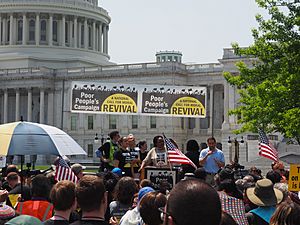Poor People's Campaign: A National Call for a Moral Revival facts for kids
 |
|
| Named after | Poor People's Campaign |
|---|---|
| Location |
|
|
Co-chair
|
William Barber II |
|
Co-chair
|
Liz Theoharis |
The Poor People's Campaign: A National Call for a Moral Revival is a big movement in the United States. It works to fight poverty and unfairness. This campaign is led by two important people, William Barber II and Liz Theoharis. They want to make life better for everyone.
Contents
What the Campaign Wants to Achieve
This campaign has clear goals to help people. They want laws that give everyone a fair wage. This means enough money to live on. They also want equal chances for all kids in school.
Fighting Unfairness and Injustice
The campaign also works to stop too many people from going to jail. They want good healthcare for everyone. And they want to make sure every person can vote. The campaign connects different types of unfairness. These include racism (being unfair because of race) and sexism (being unfair because of gender).
It also addresses unfair policies against Native American people. They fight ableism (being unfair to people with disabilities). And they challenge classism (being unfair based on how much money someone has). The campaign believes all these issues are linked.
Connecting to Past Movements
The name of this campaign comes from a movement in 1968. That original Poor People's Campaign also fought for economic justice. It was started by Martin Luther King Jr. and the Southern Christian Leadership Conference (SCLC). After King's death, Ralph Abernathy continued the work.
William Barber II says this new movement is about what is right and fair. He calls it "our humanity." The campaign gets support from many groups. One big supporter is the International Union, United Automobile, Aerospace, and Agricultural Implement Workers of America (UAW).
Forty Days of Peaceful Protests
In the spring of 2018, the campaign held "40 days of coordinated action." These events took place in state buildings across the United States. They started in May. The main event was held in Washington, DC, at the National Mall.
Focusing on Key Issues
The protests focused on three main problems. These were racism, poverty, and militarism (too much focus on war). Thousands of people marched in Washington, DC. They came from at least 32 states. Representatives from over 20 states spoke. Native American leaders also shared their stories. People traveled from as far as Alaska to join.
Working with Other Groups
Many people in the campaign are also part of other groups. These groups feel the campaign helps their goals. For example, "Fight for $15" wants to raise the national minimum wage. They want it to be a living wage. Another group is "Our Children, Our Future" from West Virginia. This group helps parents fight poverty.
"Voices of Community Activist and Leaders" - New York is another partner. This group from Harlem helps New Yorkers affected by HIV/AIDS, too many people in jail, and homelessness.
Protests and Arrests
On May 21, 2018, 21 protesters were arrested in Nashville, Tennessee. This protest happened 50 years after the original Poor People's Campaign built a temporary village. That village was called Resurrection City. Barber said this new protest was a "reenactment and reinauguration." It was not just a memory.
On June 4, 2018, 16 protesters were arrested in Topeka, Kansas. Later, William Barber II and Liz Theoharis were arrested. This happened at the Supreme Court. It was after a court decision about voter registration in Ohio. They were held for 26 hours. A week before, Dr. Theoharis was arrested in Lansing, Michigan.
On June 23, the campaign put up two large banners at the National Mall. They read, "Fight Poverty Not The Poor." More than 2,000 people were arrested across the country during the 40 days. Protesters used peaceful actions. They stopped traffic and asked state lawmakers for changes.
How It Compares to the 1960s Campaign
William Barber II has said that big changes take time. He explained that the civil rights movement did not happen quickly. He sees this new campaign as a "foundation." It is a start for a long-term effort.
The new movement aims to fix the same problems that Martin Luther King Jr. talked about. These are the issues he fought against in his original campaign. The goal is to continue that important work today.


